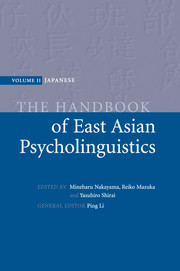Book contents
- Frontmatter
- Contents
- List of figures
- List of contributors
- In memory of Miwa Nishimura
- Preface
- Introduction
- Language acquisition
- 1 Ontogeny of language
- 2 Caregivers' speech
- 3 The intrinsic link between gesture and speech at the prelinguistic stage
- 4 Infant speech perception
- 5 Phonological acquisition
- 6 The mechanism of lexical development: implications from Japanese children's word learning
- 7 The acquisition of nouns and verbs in Japanese
- 8 The acquisition of verbal nouns
- 9 The acquisition of Japanese numeral classifiers
- 10 The acquisition of case markers
- 11 The acquisition of tense and aspect
- 12 On the origin of children's errors: the case of Japanese negation and direct passive
- 13 Binding Theory in UG and first-language acquisition of Japanese
- 14 The acquisition of the particles ne, yo, and no
- 15 The acquisition of linguistic politeness in Japanese
- 16 Children's narrative structures
- 17 Memory talk and testimony in children
- 18 Developmental dyslexia
- 19 Japanese Sign Language
- 20 The role of an innate acquisition device in second-language acquisition
- 21 Japanese, the grammar of reflexives, and second-language acquisition
- 22 Processes in L2 Japanese sentence production
- 23 The development of lexical competence among second-language readers
- 24 Reading in Japanese as a second language
- 25 Intrasentential code-switching in Japanese and English
- Part II Language processing
- References
- Name index
- Subject index
15 - The acquisition of linguistic politeness in Japanese
from Language acquisition
Published online by Cambridge University Press: 05 June 2012
- Frontmatter
- Contents
- List of figures
- List of contributors
- In memory of Miwa Nishimura
- Preface
- Introduction
- Language acquisition
- 1 Ontogeny of language
- 2 Caregivers' speech
- 3 The intrinsic link between gesture and speech at the prelinguistic stage
- 4 Infant speech perception
- 5 Phonological acquisition
- 6 The mechanism of lexical development: implications from Japanese children's word learning
- 7 The acquisition of nouns and verbs in Japanese
- 8 The acquisition of verbal nouns
- 9 The acquisition of Japanese numeral classifiers
- 10 The acquisition of case markers
- 11 The acquisition of tense and aspect
- 12 On the origin of children's errors: the case of Japanese negation and direct passive
- 13 Binding Theory in UG and first-language acquisition of Japanese
- 14 The acquisition of the particles ne, yo, and no
- 15 The acquisition of linguistic politeness in Japanese
- 16 Children's narrative structures
- 17 Memory talk and testimony in children
- 18 Developmental dyslexia
- 19 Japanese Sign Language
- 20 The role of an innate acquisition device in second-language acquisition
- 21 Japanese, the grammar of reflexives, and second-language acquisition
- 22 Processes in L2 Japanese sentence production
- 23 The development of lexical competence among second-language readers
- 24 Reading in Japanese as a second language
- 25 Intrasentential code-switching in Japanese and English
- Part II Language processing
- References
- Name index
- Subject index
Summary
Introduction
Japanese is well known for its elaborate system of linguistic politeness, or keigo. For non-native speakers, keigo can be extremely difficult to master. However, Japanese children seem to acquire many features of verbal politeness effortlessly, at a relatively early age. How does this happen?
Japanese linguistic politeness has conventionally been divided into three basic categories (see Martin, 1975 or Hayashi & Minami, 1973, for a full description of the keigo system):
(1) Sonkeigo “honorific language” (subject honorifics). Honorific forms are used by increasing the vertical distance between the speaker and referent by “elevating” the referent. They are used to refer to the referent, his/her actions, or belongings.
(2) Kenjoogo “humble language” (nonsubject honorifics). Humble forms are used by increasing the vertical distance between the speaker and referent by “lowering” the speaker. They are used to refer to the speaker or an in-group member, his/her actions, or belongings.
(3) Teineigo “formal style” (addressee honorifics). Sentences ending with desu/masu predicates are formal, while those ending in da/ru style are informal. Nominal and adjectival forms also change according to formality. Many factors, such as age, status, and degree of familiarity, influence formal style usage.
In addition, two more categories have been proposed, namely bikago “beautification honorifics” which make language sound more refined (e.g. polite prefixes o- and go-, as in o-sushi for “sushi”) and teichoo-go “courteous language” or linguistic behavior which elevates the referent (e.g. polite adverbial expressions, lexical choices, such as shooshoo for sukoshi “a little”) (e.g. Sakamoto, 2002).
- Type
- Chapter
- Information
- The Handbook of East Asian Psycholinguistics , pp. 110 - 115Publisher: Cambridge University PressPrint publication year: 2006
- 3
- Cited by



